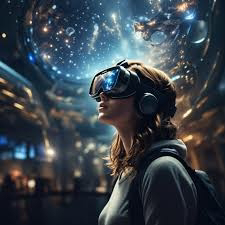In recent years, technological advancements have revolutionized the way we live, work, and interact. Among these groundbreaking technologies, virtual reality (VR) stands out as one of the most captivating and immersive experiences available today. With the ability to transport users to entirely different worlds, virtual reality has swiftly become a game-changer in various fields, including entertainment, education, healthcare, and even business.
At its core, virtual reality refers to a simulated environment that replicates reality or creates an entirely new, fabricated world. By wearing a VR headset, users are transported into a fully immersive 3D environment, where they can see and interact with objects and characters as if they were physically present. This technology holds the potential to deliver incredibly realistic and engaging experiences, blurring the line between the virtual and real worlds.
In the realm of entertainment, virtual reality has opened up a whole new dimension of possibilities. Whether it is exploring alien planets, diving deep into the ocean, or embarking on thrilling adventures, VR allows users to be at the very center of the action. With the integration of haptic feedback and motion tracking devices, users can feel the impact of their actions and move freely within the virtual space, providing a truly transformative sensory experience.
Beyond entertainment, virtual reality has made significant strides in education. Traditional teaching methods often struggle to capture students' engagement and provide hands-on experiences. However, virtual reality has the power to recreate historical events, simulate scientific experiments, or take students on virtual field trips. By embodying historical figures or manipulating virtual objects, students can gain a deeper understanding of complex concepts. VR technology has the potential to democratize education by making immersive learning experiences accessible to students regardless of their location or resources.
In the realm of healthcare, virtual reality has emerged as a valuable tool for both patients and medical professionals. For patients, VR experiences can help alleviate pain and anxiety during medical procedures or provide therapeutic interventions for various conditions. Doctors and medical staff can also employ virtual reality for training purposes, allowing them to practice complex surgeries or enhance their diagnostic skills in a safe and controlled environment. Such applications are not only cost-effective but also have the potential to save lives and improve patient outcomes.
Moreover, virtual reality has found its place in the business world, offering enhanced communication and collaboration opportunities. With virtual conferences and meetings, colleagues from around the world can come together in a shared virtual space, reducing travel costs and increasing productivity. VR can also revolutionize the design and prototyping process, enabling architects, engineers, and designers to visualize and interact with their creations before physical construction begins.
As virtual reality continues to evolve, its potential applications seem limitless. From therapeutic experiences and training simulations to architectural visualization and social interactions, virtual reality has the power to transform industries and reshape our daily lives. However, like any emerging technology, there are still challenges to overcome, such as the high cost of entry, motion sickness concerns, and the need for more robust content creation.
In conclusion, virtual reality is a technology that is pushing the boundaries of human experience. Its ability to immerse users in entirely new worlds provides unprecedented opportunities for education, entertainment, healthcare, and business. As the technology continues to advance, we can expect virtual reality to become an integral part of our lives, enhancing our understanding of the world and redefining how we interact with it.



No comments:
Post a Comment